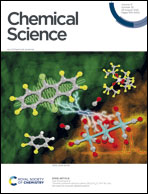Crystal engineering of ferrocene-based charge-transfer complexes for NIR-II photothermal therapy and ferroptosis†
Abstract
Organic charge-transfer complexes (CTCs) can function as versatile second near-infrared (NIR-II) theranostic platforms to tackle complicated solid tumors, while the structure–property relationship is still an unanswered problem. To uncover the effect of molecular stacking modes on photophysical and biochemical properties, herein, five ferrocene derivatives were synthesized as electron donors and co-assembled with electron-deficient F4TCNQ to form the corresponding CTCs. The crystalline and photophysical results showed that only herringbone-aligned CTCs (named anion-radical salts, ARS NPs) possess good NIR-II absorption ability and a photothermal effect for short π–π distances (<3.24 Å) and strong π-electron delocalization in the 1D F4TCNQ anion chain. More importantly, the ARS NPs simultaneously possess ·OH generation and thiol (Cys, GSH) depletion abilities to perturb cellular redox homeostasis for ROS/LPO accumulation and enhanced ferroptosis. In vitro experiments, FcNEt-F4 NPs, and typical ARS NPs, show outstanding antitumor efficiency for the synergistic effect of NIR-II photothermal therapy and ferroptosis, which provides a new paradigm to develop versatile CTCs for anti-tumor application.



 Please wait while we load your content...
Please wait while we load your content...